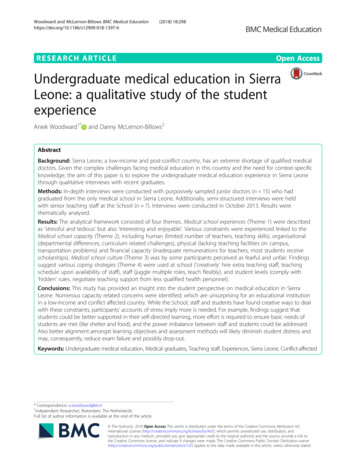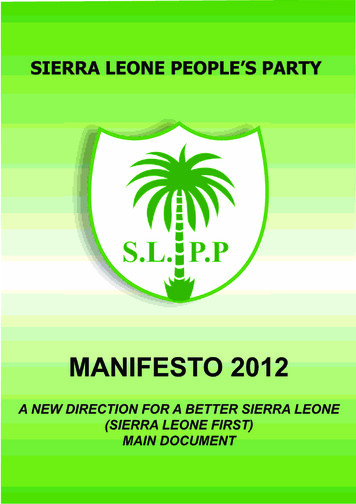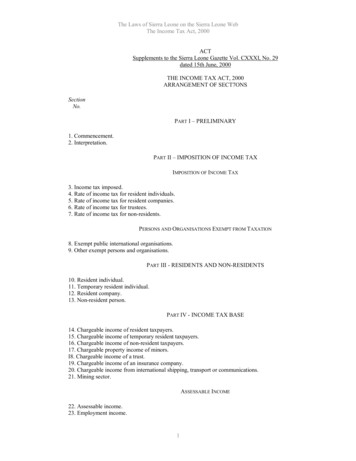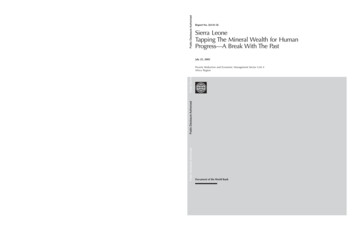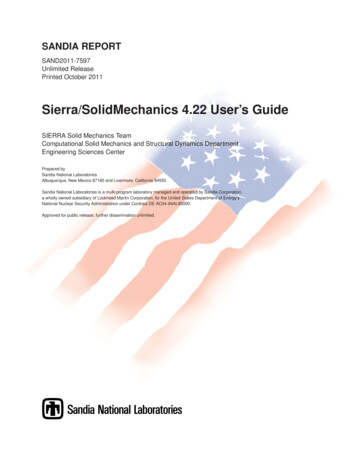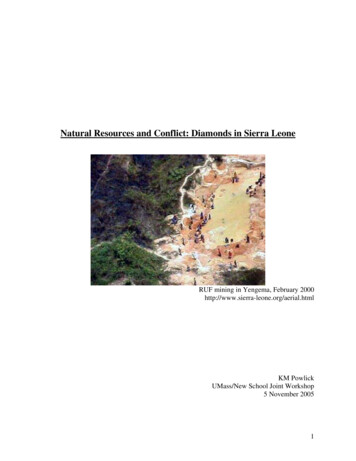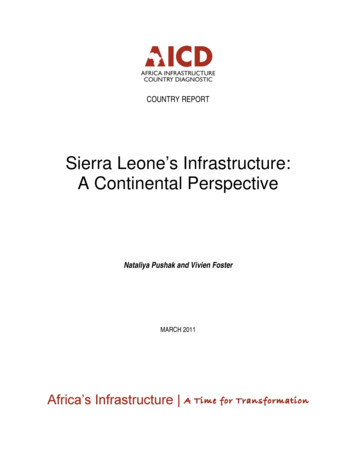
Transcription
COUNTRY REPORTSierra Leone’s Infrastructure:A Continental PerspectiveNataliya Pushak and Vivien FosterMARCH 2011
2010 The International Bank for Reconstruction and Development / The World Bank1818 H Street, NWWashington, DC 20433 USATelephone: 202-473-1000Internet: www.worldbank.orgE-mail: feedback@worldbank.orgAll rights reservedA publication of the World Bank.The World Bank1818 H Street, NWWashington, DC 20433 USAThe findings, interpretations, and conclusions expressed herein are those of the author(s) and do not necessarily reflect the views of theExecutive Directors of the International Bank for Reconstruction and Development / The World Bank or the governments they represent.The World Bank does not guarantee the accuracy of the data included in this work. The boundaries, colors, denominations, and otherinformation shown on any map in this work do not imply any judgment on the part of The World Bank concerning the legal status of any territoryor the endorsement or acceptance of such boundaries.Rights and permissionsThe material in this publication is copyrighted. Copying and/or transmitting portions or all of this work without permission may be a violation ofapplicable law. The International Bank for Reconstruction and Development / The World Bank encourages dissemination of its work and willnormally grant permission to reproduce portions of the work promptly.For permission to photocopy or reprint any part of this work, please send a request with complete information to the Copyright ClearanceCenter Inc., 222 Rosewood Drive, Danvers, MA 01923 USA; telephone: 978-750-8400; fax: 978-750-4470; Internet: www.copyright.com.All other queries on rights and licenses, including subsidiary rights, should be addressed to the Office of the Publisher, The World Bank, 1818H Street, NW, Washington, DC 20433 USA; fax: 202-522-2422; e-mail: pubrights@worldbank.org.
About AICD and its country reportsThis study is a product of the Africa Infrastructure Country Diagnostic (AICD), a project designed toexpand the world’s knowledge of physical infrastructure in Africa. The AICD provides a baseline againstwhich future improvements in infrastructure services can be measured, making it possible to monitor theresults achieved from donor support. It also offers a solid empirical foundation for prioritizinginvestments and designing policy reforms in Africa’s infrastructure sectors.The AICD is based on an unprecedented effort to collect detailed economic and technical data on Africaninfrastructure. The project has produced a series of original reports on public expenditure, spendingneeds, and sector performance in each of the main infrastructure sectors, including energy, informationand communications technologies, irrigation, transport, and water and sanitation. Africa’sInfrastructure—A Time for Transformation, published by the World Bank and the Agence Française deDéveloppement in November 2009, synthesized the most significant findings of those reports.The focus of the AICD country reports is on benchmarking sector performance and quantifying the mainfinancing and efficiency gaps at the country level. These reports are particularly relevant to nationalpolicy makers and development partners working on specific countries.The AICD was commissioned by the Infrastructure Consortium for Africa following the 2005 G8 (Groupof Eight) summit at Gleneagles, Scotland, which flagged the importance of scaling up donor finance forinfrastructure in support of Africa’s development.The first phase of the AICD focused on 24 countries that together account for 85 percent of the grossdomestic product, population, and infrastructure aid flows of Sub-Saharan Africa. The countries are:Benin, Burkina Faso, Cape Verde, Cameroon, Chad, Côte d’Ivoire, the Democratic Republic of Congo,Ethiopia, Ghana, Kenya, Lesotho, Madagascar, Malawi, Mozambique, Namibia, Niger, Nigeria, Rwanda,Senegal, South Africa, Sudan, Tanzania, Uganda, and Zambia. Under a second phase of the project,coverage was expanded to as many of the remaining African countries as possible.Consistent with the genesis of the project, the main focus is on the 48 countries south of the Sahara thatface the most severe infrastructure challenges. Some components of the study also cover North Africancountries so as to provide a broader point of reference. Unless otherwise stated, therefore, the term Africais used throughout this report as a shorthand for Sub-Saharan Africa.The World Bank has implemented the AICD with the guidance of a steering committee that represents theAfrican Union, the New Partnership for Africa’s Development (NEPAD), Africa’s regional economiccommunities, the African Development Bank (AfDB), the Development Bank of Southern Africa(DBSA), and major infrastructure donors.
Financing for the AICD is provided by a multidonor trust fund to which the main contributors are theUnited Kingdom’s Department for International Development (DFID), the Public Private InfrastructureAdvisory Facility (PPIAF), Agence Française de Développement (AFD), the European Commission, andGermany’s Entwicklungsbank (KfW). A group of distinguished peer reviewers from policy-making andacademic circles in Africa and beyond reviewed all of the major outputs of the study to ensure thetechnical quality of the work. The Sub-Saharan Africa Transport Policy Program and the Water andSanitation Program provided technical support on data collection and analysis pertaining to theirrespective sectors.The data underlying AICD’s reports, as well as the reports themselves, are available to the public throughan interactive Web site, www.infrastructureafrica.org, that allows users to download customized datareports and perform various simulations. Many AICD outputs will appear in the World Bank’s PolicyResearch Working Papers series. Inquiries concerning the availability of data sets should be directed tothe volume editors at the World Bank in Washington, DC.
ContentsList of figuresiii List of tablesiii Acknowledgmentsiv Synopsis1 The continental perspective3 Why infrastructure matters4 The state of Sierra Leone’s infrastructure6 14 21 21 26 28 30 31 33 37 PowerTransportRoadsPortsAir transportWater resourcesIrrigationWater supply and sanitationInformation and communication technologies41 Financing Sierra Leone’s infrastructureHow much more can be done within the existing resource envelope?Annual funding gapWhat else can be done?43 47 47 50 BibliographyList of figuresFigure 1. Sierra Leone’s economy is projected to reboundFigure 2. Infrastructure’s low contribution to growth in Sierra Leone could be much greaterFigure 3. Sierra Leone’s infrastructure follow mineral resources and populationFigure 4. Substantial reduction in the costs of power productionFigure 5. Sierra Leone power tariffs are amongst the highest in AfricaFigure 6. Underpricing and network losses have been major challenges at different periods for NPAFigure 7. Sierra Leone’s share of revenues forgone due to power losses is the highest in West AfricaFigure 8. Sustainable cost recovery for Sierra Leone in the medium term is still a difficult propositionFigure 9. Sierra Leone roads type and condition versus road trafficFigure 10. Sierra Leone’s fuel levy and public contribution fall short of maintenance and rehabilitation needs of road networkFigure 11. Sierra Leone’s spending is not sufficient to cover maintenance and rehabilitation needsFigure 12. Evolution of capacity and city pairs in Sierra LeoneFigure 13. Sierra Leone’s irrigation areaFigure 14. Sierra Leone’s irrigation area potential (baseline scenario)Figure 15. Expansion of water and sanitation technologies at the national, urban, rural levelsFigure 16. Urban versus rural access to water supply and sanitation, 2008Figure 17. Freetown’s water utility suffers from hidden costs of inefficienciesFigure 18. Around 9 percent of Siera Leone’s population can be reached by GSM signal only with a subsidyFigure 19. Telecom coverage in Sierra LeoneFigure 20. Sierra Leone’s infrastructure spending needs are high relative to GDPiii5 6 8 15 18 19 20 20 22 24 25 29 31 32 35 35 37 40 40 42
Figure 21. Sierra Leone’s existing infrastructure spending is averageFigure 22. Sierra Leone’s pattern of capital investment in infrastructure differs from that of comparator countriesFigure 23. Underpricing of power and water is less burdensome in Sierra Leone than in comparator countriesFigure 24. Affordability in Sierra Leone better than in other low income countries, but access to services is very lowFigure 25. Sierra Leone’s power and water utilities burden of inefficiencyFigure 26. Sierra Leone needs to attract more private investments beyond the ICT sector44 44 45 46 47 48 List of tablesTable 1. Achievements and challenges in Sierra Leone’s infrastructure sectorsTable 2. Sierra Leone pays more for fuel than most of its neighborsTable 3. Benchmarking Sierra Leone’s power infrastructureTable 4. Large hidden costs corrode revenues from NPATable 5. Sierra Leone road indicators benchmarked against Africa’s low- and middle-income countriesTable 6. Benchmarking port indicators: Freetown as compared with selected other ports*Table 7. Benchmarking air-transport indicators for Sierra Leone and selected other countriesTable 8. Sierra Leone's irrigation potentialTable 9. Benchmarking water and sanitation indicatorsTable 10. Sierra Leone’s ICT sector in comparative contextTable 11. Illustrative investment targets for infrastructure in Sierra LeoneTable 12. infrastructure spending needs in Sierra Leone for 2006 to 2015Table 13. Financial flows to Sierra Leone’s infrastructureTable 14. Sierra Leone’s potential gains from greater operational efficiencyTable 15. Funding gaps by sectorTable 16. Savings from innovation14 16 17 19 23 28 30 32 34 38 41 42 43 45 47 49 AcknowledgmentsThis paper draws on contributions from sector specialists from the Africa Infrastructure CountryDiagnostic Team; notably, Heinrich Bofinger on air transport, Carolina Dominguez-Torres on water andsanitation, Michael Minges on information and communication technologies, Alberto Nogales on roads,Nataliya Pushak and Cecilia M. Briceño-Garmendia on public expenditure, Rupa Ranganathan on power,and Alvaro Federico Barra on spatial analysis.The paper is based on data collected by local consultants and benefited greatly from feedbackprovided by colleagues in the relevant World Bank country teams; notably, Waqar Haider (SectorLeader), Mudassar Imran (energy), Manuel Berlengiero (energy), and Adam Vickers, Nelson Mokgethiand Afua Sarkodie (local consultants).iv
SynopsisInfrastructure has contributed significantly to the growth of West African economies during the pastdecade. In Sierra Leone, infrastructure added only around 0.51 percentage points to the per capita growthrate over 2003–07. Similarly to other countries in the region and the rest of the continent, the boost tohistoric growth came predominately from the ICT (Information and Telecommunications Technology)revolution while power-sector deficiencies and poor roads held back growth. However, infrastructurecould contribute more in the future than it has in the past. If Sierra Leone could upgrade its infrastructureto the level of the best performer in Africa, per capita growth rates could be boosted by more than threepercentage points.After nine years of peace, economic activity is flourishing at every level in Sierra Leone. Politicalstability, high government accountability, good governance standards, and streamlined tax reform helpedSierra Leone to become a bright success story, turning the country into the easiest and quickest place tostart business in West Africa (ICA/WBG 2011). Sierra Leone’s image in the eyes of investors isstrengthened as the country ranked as one of the top five countries in Africa for investor protection.Sierra Leone’s 11-year civil war destroyed the country’s infrastructure. Much effort was put intorebuilding and modernizing infrastructure networks, but it proved to be a difficult task. Resolvingbottlenecks that the poor state of infrastructure poses on economic and social development will takeSierra Leone a long time and much coordinated effort. Sierra Leone expanded its hydropower capacity bybuilding the 50-megawatt Bumbuna hydropower plant. This significantly reduced the cost of powerproduction. Since Bumbuna has been operational, power tariffs fell from 0.41 to 0.31 per kilowatthour. Progress has been made in terms of improving operational efficiency. Development of the powersector is high on the governmental agenda, but it will take long time to achieve given the low startingbase. Around 20 percent of the urban population has access to piped water. Community-led totalsanitation (CLTS) approaches that bring improved sanitation to whole communities have proved to be asuccess. Sierra Leone has the beginning of a national road network, has prospects for regionalconnectivity, and has established a Road Fund. The country has made good progress in securing donorfinancing for road reconstruction, and important projects in the sector are underway. The port ofFreetown, badly damaged during the war, has undertaken essential rehabilitation works and sound reformforeseeing increased private participation. Sierra Leone used wireless communications to leapfrog its ICTdevelopment, its number of mobile subscriptions going from just 6,000 in 2000 to 1.4 million by 2009 fora penetration rate of one quarter of the population.Looking ahead, the country faces a number of critical infrastructure challenges. Perhaps the mostdaunting of these challenges lies in the power sector, the poor state of which retards development of othersectors. Access to power is very low, at around 1 to 5 percent in urban areas, and is nonexistent in thecountryside. The country’s installed power-generation capacity is around 13 megawatts per millionpeople, which is lower than what other low-income and fragile states have installed. The entire existingpower infrastructure is concentrated in the western part of the country, and even with the functioning of
SIERRA LEONE’S INFRASTRUCTURE: A CONTINENTAL PERSPECTIVEthe Bumbuna power plant, only half the suppressed demand for Freetown, let alone that for the rest of thecountry, is being met.Regardless of recent reduction in tariffs, Sierra Leoneans still pay some of the highest tariffs inAfrica. In 2010, Sierra Leoneans paid three times as much for power as did residents of African countriesthat relied on hydropower. Making investments in more cost-effective power generation options istherefore an important strategic objective for Sierra Leone, without which further electrification willsimply be unaffordable for the wider population.Water service is increasingly unreliable in the urban areas, and performance of Sierra Leone’s waterutilities is poor. The lack of sanitary facilities is one of the major contributory factors to Sierra Leone’sexceptionally high maternal- and child-mortality rates. Only one percent of the rural population hasaccess to piped water.The overall state of road infrastructure is poor. The current fuel levy is not sufficient to covermaintenance, not to mention extensive rehabilitation, of roads. Sierra Leone would need to triple itsannual rehabilitation expenditure in order to complete road rehabilitation in a five-year period. Thiswould mean raising fuel levies and improving the transparency and fairness of the tax, while still relyingon donor and governmental finance. Sierra Leone would need to provide better access to its main airportat Freetown, currently reachable only by ferries. The country’s port system needs both new investmentsand rehabilitation.Addressing Sierra Leone’s infrastructure challenges will require a sustained expenditure of 258–478million per year. This is based on achieving an illustrative set of infrastructure targets, and considers onlypublic infrastructure needs without taking into account the private infrastructure needs of the concessionsassociated with the mineral, forestry, and agriculture industries. A range is given because differenttechnologies and standards can be used to meet these targets, with significant impact on costs. Water,transport, and power have the largest weight in this overall price tag. This cost looks daunting relative tothe 2009 GDP of around 1.9 billion, but less so relative the country’s vast mineral and natural-resourcewealth.In recent years, Sierra Leone has been spending some 134 million a year on infrastructure when allsources public and private, budget and off-budget are borne in mind. This is equivalent to 10 percent ofGDP—an average level of effort compared to other African countries, though still only about half of theapproximately 20 percent of GDP that China has spent on infrastructure in recent years. About 70 percentof total infrastructure spending has been investment, and more than half has gone to the transport sector.Official development assistance (ODA), provided by the member countries of the Organisation forEconomic Co-operation and Development (OECD), is by far the largest source of investment finance,followed by private investment; while domestically funded public investment has been lower. A further 66 million has been lost to inefficiencies, mainly due to high power losses and the underrecovery ofcosts in roads and water, and it should be possible to recapture at least part of these resources throughcareful policy choices.Comparing spending needs against existing spending and potential efficiency gains leaves an annualfunding gap of 59 to 278 million per year, most of it associated with water, power and transport. Onceagain, the range of the gap depends on the technology choices. The overall savings from selecting optimal2
SIERRA LEONE’S INFRASTRUCTURE: A CONTINENTAL PERSPECTIVEtechnology choices could reduce the funding gap by three quarters. While the funding gap is large relativeto the economy, there are a number of options for making it more manageable.The first observation is that this shortfall need not be entirely funded by the public sector. SierraLeone has already established a strong track record on Foreign Direct Investment, and has in recent yearscaptured 1.4 percent of GDP as private investment for infrastructure (essentially all for the ICT sector).Although not all components of the required infrastructure platform are suitable for private finance (inparticular not roads, water or sanitation), other components may be (for example, in ICT, powergeneration, and ports).The second observation is that a number of large multinational companies have taken on the country’snumerous mineral, forestry, and agricultural concessions, and are themselves investing heavily in thenecessary transport and energy platforms to support their operations. Sierra Leone has a policy ofensuring that such investments are done in such a way as to benefit the broader national economy, andhence could potentially contribute to meeting the overall need.Nevertheless, given the size of the funding gap, Sierra Leone will likely need to consider a periodlonger than a decade to reach the illustrative infrastructure targets here outlined. If the efficiency potentialcould be fully captured, Sierra Leone could meet the posited targets in about 30 years. However, underbusiness-as-usual assumptions on spending and efficiency, it would take much longer for Sierra Leone toreach these goals.In the medium term, therefore, Sierra Leone needs to make difficult decisions regarding theprioritization of infrastructure investments. For that reason, to the nation must have a clear understandingof how infrastructure contributes to its national-development and poverty-reduction strategies to provide aclear and objective basis for prioritization. Recent work on the identification of key developmentcorridors for the country could help to support such decisions. Where resources are limited, there is adanger in spreading infrastructure investments too thin to make a real economic and social impact, andthe need to think strategically about bundling and sequencing investments for maximum returns.The continental perspectiveThe Africa Infrastructure Country Diagnostic (AICD) has gathered and analyzed extensive data oninfrastructure in more than 40 Sub-Saharan countries, including Sierra Leone. The results have beenpresented in reports covering different areas of infrastructure—ICT, irrigation, power, transport, waterand sanitation—and different policy areas—including investment needs, fiscal costs, and sectorperformance.This report presents the key AICD findings for Sierra Leone allowing the country’s infrastructuresituation to be benchmarked against that of its African peers. The report provides a general overview ofthe state of the economic infrastructure sectors in Sierra Leone. Given that Sierra Leone is at presentfragile low income country, two sets of African benchmarks will be used to evaluate Sierra Leone’ssituation: fragile low income countries and non-fragile low income countries. Detailed comparisons willalso be made with immediate regional neighbors in the Economic Community of West African States(ECOWAS) countries.3
SIERRA LEONE’S INFRASTRUCTURE: A CONTINENTAL PERSPECTIVESeveral methodological issues should be borne in mind. First, because of the cross-country nature ofdata collection, a time lag is inevitable. The period covered by the AICD runs from 2001 to 2006 forcountries for which data was collected in the first phase of the project. For some of the countries,considered phase 2 countries like Sierra Leone, data collection began later. In the particular case of SierraLeone, data is collected predominately for the 2007–2009 period. Most technical data presented aretypically 2006 for the benchmarks, while financial data for comparator countries are averaged over theavailable period to smooth out the effect of short-term fluctuations.Second, in order to make comparisons across countries, we had to standardize the indicators andanalysis so that everything was done on a consistent basis. This means that some of the indicatorspresented here may be slightly different from those that are routinely reported and discussed at thecountry level.Why infrastructure mattersIn common with the rest of the continent, Western Africa’s growth performance improved markedlyin the 2000s. The overall improvement in per capita growth rates has been estimated at 1.19 percentagepoints, of which 1.12 percent is attributable to better structural policies and 0.88 percent to improvedinfrastructure, with stabilization policies and external factors retarding growth by 0.81 percent.Since the end of the 11-year civil war in 2002, Sierra Leone’s economy expanded at annual averagerate of close to 10 percent, led by agriculture, construction, services, and mining. Though the globaleconomic crisis led to an almost 40 percent reduction in demand for diamonds—Sierra Leone’s mainexport item—the economy continued to grow, albeit at a slower rate, and is expected to rebound(figure 1). Such strong performance is to a great extent a result of sound economic and fiscal policies, andgood performance of the key sectors. In addition, recently discovered off-shore oil reserves1 and irondeposits are likely to further boost the economy, once commercially explored.1Expectations about a boost in the real sector were heightened with news about the prospects of potential oilreserves in the deep-water offshore area within the Sierra Leone-Liberia basin. Anadarko Petroleum Corporation, aUnited States oil firm which made the discovery indicated that the new well - called Venus - is one of more than 30identified prospects across 10 blocks offshore of Sierra Leone, Liberia, Ivory Coast and Ghana. This was positivenews for the country going forward and has significant potentials to increase Sierra Leone’s revenues (Bank ofSierra Leone, Annual Report 2009).4
SIERRA LEONE’S INFRASTRUCTURE: A CONTINENTAL PERSPECTIVE Figure 1. Sierra Leone’s economy is projected to rebound" ! ! " " # # Sources: International Monetary Fund and World Bank staff estimates and projections; World Bank 2010.Notes: The GDP estimates are provisional and remain subject to review.Despite improvements in infrastructure, Sierra Leone added only 0.51 percentage points to the percapita growth rate from 2003 to 2007—much less than most other countries in the region or many otherfragile countries. But like other African countries, the boost came predominately from the ICT revolution,while power-sector deficiencies and poor roads held back per capita growth by 0.08 and 0.05 percentagepoints respectively (figure 2a). Looking ahead, simulations suggest that if Sierra Leone’s infrastructurecould be improved to the level of the African leader—Mauritius—annual per capita growth rates wouldbe 3.34 percentage points higher than they are at present. This impact would come from improvementsnot only in ICT, but also from increase in power-generating capacity and better road infrastructure(figure 2b).5
SIERRA LEONE’S INFRASTRUCTURE: A CONTINENTAL PERSPECTIVEFigure 2. Infrastructure’s low contribution to growth in Sierra Leone could be much greater% changes in growth per capitadue to changes in infrastructure(2001-5 vs. 1991-5)a. Infrastructure’s contribution to annual per capita economic growth in selected countries, 2003–07, in percentage points b. Potential contributions of infrastructure to annual per capita economic growth in selected countries, in percentage pointsPotential changes in growth percapita from improvinginfrastructure to level of Africanleader (Mauritius) Source: Calderon 2009.The state of Sierra Leone’s infrastructureSierra Leone’s population of 5.7 million is sparsely distributed across the country, with more denselypopulated urban areas surrounding the major cities, and very lightly populated areas in the north. Morethan 60 percent of the population lives in rural areas. Poverty is high at around 70 percent of thepopulation (figure 3a, b). Sierra Leone has mountains in the east, while the rest of the country is dividedbetween plateau, hills, and coastal mangrove zones (figure 3c).Sierra Leone enjoys an advantageous geographical location and is endowed with a wealth of naturalresources including minerals—, such as diamonds, bauxite and rutile—forests, fresh water, fertile lands, anatural harbor, and potential off-shore oil reserves. The favorable climate and land resources provide for6
SIERRA LEONE’S INFRASTRUCTURE: A CONTINENTAL PERSPECTIVEvast agriculture potential (figure 3d). At present, agricultural activity is concentrated in the north, whilethe south has significant unexploited potential.However, transport infrastructure is presently inadequate to support agriculture (figure 3f). Most ofthe public infrastructure was either damaged or allowed to dilapidate during the years of civil war. Nineyears after the war, Sierra Leone has only the beginning of national road network, with the main arteryconnecting the nation with neighboring Guinea and Liberia in plans, and still in poor condition alongmany sections. The roads network is in dire need of rehabilitation and new investments, particularly inrural areas. The southeastern part of the country appears to have pockets of population not covered by anymajor infrastructure network. In addition, the development of Sierra Leone’s mining sector requiresadequate infrastructure to support it. Despite its comparatively small size, the country has impressivemining potential. The revival of the mining sector in Sierra Leone so far was largely limited to reopeningof the existing mines and tapping already proven reserves. New investments into the sector are highlydesirable, and contingent on infrastructure facilities, many of which could potentially be developed bymining companies themselves and could bring broader benefits to the rural economy. CT coverage isquite good (figure 3g), but a lack of power has slowed sector development—it is often more problematicin Sierra Leone to charge a phone than to pay for telecom services. Sierra Leone’s is not connected to aninternational fiber-optic cable, but plans to become connected in the near future, and currently has amicrowave link to Guinea.Sierra Leone has the beginnings of a national power grid, with a single transmission line connectingFreetown to the hydro plant at Bumbuna along one of the country’s main potential mining corridors. Theplanned Cote d’Ivoire–Liberia–Sierra Leone–Guinea (CLSG) line that the WAPP (West African PowerPool) would lay is a high-voltage transmission line along the coast connecting Sierra Leone to Guinea,Liberia, and ultimately Côte d’Ivoire. 2Although Sierra Leone is water abundant country (figure 3h), the system of water and sanitation is indisarray and cannot meet the mounting pressures of a rapidly growing urban population, much lessexpanding coverage to rural areas . Growing mining and agriculture sectors also put pressure on existingwater resources. There is significant use of irrigation along the coast and to the north of the country. Theextensive river network has significant hydroelectric potential, though the county experiences asuccession of wet and dry seasons, which would limit the extent of firm energy.This report begins by reviewing the main achievements and challenges in each of Sierra Leone’smajor infrastructure sectors, with the key findings summarized below (table 1). Thereafter, attention willturn to the problem of how to finance Sierra Leone’s outstanding infrastructure activities/grants/w
Sierra Leone's potential gains from greater operational efficiency 45 Table 15. Funding gaps by sector 47 Table 16. . The paper is based on data collected by local consultants and benefited greatly from feedback . Calderón, César. 2009. "Infrastructure and Growth in Africa," Policy Research Working Paper 4914, World Bank, Washington .

